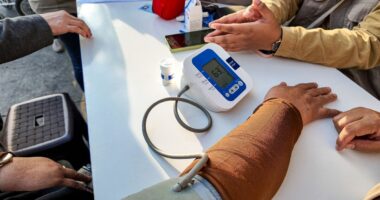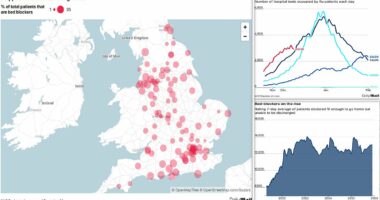Share this @internewscast.com
During the first years of the Covid-19 crisis, the University of New South Wales professor of global biosecurity Raina MacIntyre was a fixture on Australian TVs and news feeds, a voice of authority and warning about the dangers faced by societies grappling with the “Black Swan event” that was the global pandemic. In a new book, she turns her mind to the threats that are coming around the bend.
In your new book, Vaccine Nation, you write that vaccination is arguably the greatest public health achievement in history, yet 200 years of progress is now in peril. Where might we be without vaccines?
Raina McIntyre: Unicef estimates that in the absence of a vaccine, the world would have seen 5 million deaths due to smallpox every year in the mid-1990s. I am sure anti-vaccine groups would be raging against the statistic that smallpox vaccines, by achieving eradication, has prevented over 190 million deaths since 1980.
Without vaccines, we would see a rise in vaccine-preventable diseases like measles, polio, meningitis and so on, and a rise in infant mortality as a result. Until about 20 years ago, infectious diseases were among the leading causes of death in the world. We may see previously rare infectious diseases climb again to become a top cause of death in the world. Covid and lower respiratory infections are already in the top 10.
We are seeing epidemics of measles everywhere today, for example. We need very high vaccination rates against measles to prevent epidemics. In Australia and all over the world, childhood vaccination rates have started to decline after the Covid pandemic, and this in part explains the resurgence of vaccine-preventable diseases. We have to be very careful to maintain good control of measles in this country.
What keeps you awake at night, in terms of the possible explosion of disease transmission?
I worry about an influenza pandemic or a smallpox-like pandemic.
Influenza pandemics have occurred throughout history, and happen when a novel bird flu virus mixes with a human flu virus to create a brand new pandemic strain that can spread easily between humans. Typically, a flu pandemic has a high fatality rate. The 1918 Spanish flu pandemic caused deaths in the very young, the very old and also in healthy young people. The unprecedented spread of H5N1 influenza across the world since 2020 has increased the probability of an influenza pandemic arising from this virus mutating to adapt to humans.
Smallpox was eradicated in 1980, but keeps me awake because it can be synthesised in a lab, and the methods to do this have been described in open access scientific journals. There may also be countries with clandestine stocks of live virus, which could be used as a biological weapon. Smallpox has a very high fatality rate, with one in three people dying. If it were to re-emerge, the impact would be devastating.
We do, however, have vaccines that can protect against smallpox and which are highly effective. These same vaccines were used for the recent mpox epidemic. Mpox is similar to smallpox, less deadly, but still serious. One of the variants, called clade 1, can kill up to 10% of people it infects. This clade has been spreading in a number of countries, including the Democratic Republic of Congo, and has shown some worrying mutations that may increase contagiousness between humans. This too, keeps me awake.
In your book you outline how the anti-vaxxing community isn’t the only threat to protecting our herd immunity – what else is happening here?
The mass dissemination of misinformation and disinformation has also affected the medical profession, who find it increasingly more challenging to separate fact and fiction because of the range of pseudoscientific material that has flooded the landscape. Predatory journals and publications have been increasing for over a decade. These journals charge the authors high fees for vanity publishing. They use names very similar to reputable journals, but have dodgy standards and practices. Essentially, anyone with a theory can get a scientific paper published in one of these dodgy journals. I have seen doctors circulating junk science about vaccines, thinking it is the real thing.
Then there are a small number of prominent medical practitioners with large social media followings who began promoting anti-vaccination messages during the Covid-19 pandemic. The vast and instant reach of social media today also makes this much more challenging.
What is the best way to talk to someone who is not an outright anti-vaxxer, but may be vaccine hesitant?
Vaccine refusers maybe about 2% of the population, but the hesitant people are a much larger group, maybe 10%. People who are vaccine hesitant and who do not feel they have been listened to adequately by health professionals may be more vulnerable to recruitment by the anti-vaccine lobby. This is why it is important for health professionals to be able to distinguish between outright vaccine refusers and those who are hesitant, and then to spend time discussing vaccination with their hesitant patients.
What’s the key to restoring public trust in vaccines?
after newsletter promotion
It will not be an easy task. This needs to be a combined effort by government and non-government organisations, including consumer and community organisations. Being able to monitor and track disinformation would be helpful to governments to enable early response and health promotion. We have recently received a research grant to develop an AI sentiment and disinformation tracking tool, but such tools are not available or used routinely in health yet. Trust in government is obviously a key part of this. In research that we have done, we showed that Australians are much more trusting of government around public health than, for example, Americans or the British. This is an advantage we should not squander.
Are you still wearing masks? Should we still?
I do in crowded public spaces or if I am visiting my parents in their nursing home. I don’t want to put vulnerable people at risk and I don’t want to get repeated infections. I read the research on the chronic disease impacts of Covid and would like to mitigate those risks. It has improved my quality of life substantially, as I get very severe asthma with any respiratory infection.
I also wear masks when travelling, in airports and on the plane. Aircraft actually have really good ventilation systems, but the air filtration doesn’t kick in until you are airborne. Therefore, the highest risk period of catching an infection is when you’re on the tarmac. In one case study, a person with influenza was on board a plane where takeoff was delayed for three hours. This resulted in 70% of the passengers on the plane getting infected. A mask is such a simple mitigation to prevent infection.
Do you believe we will face another pandemic and will we be better prepared for it?
Yes, it’s a matter of when, not if – pandemics have occurred throughout history and there are factors that make the risk greater today. We have seen an unprecedented acceleration of bird flu around the world from 2020 onward. We have seen farm outbreaks become endemic in the United states and with H5N1 fragments detected in dairy products. The probability of a pandemic is much higher today simply because there’s so much more bird flu, in so many more places, that makes genetic mutation more likely.
We would certainly be better prepared for an influenza pandemic than we were for Covid-19, because influenza is a highly researched virus and we already have effective influenza vaccines. If a new pandemic influenza virus arose, the vaccines simply have to be matched to that exact strain, rather than developed from scratch. Thanks to the Covid-19 pandemic, we also have mRNA technology at our fingertips, which may also contribute to better pandemic response.
The one area which will hinder any future pandemic response is the huge backlash to public health measures that has been seen following the Covid-19 pandemic. There will be a lot of work involved in winning the trust of communities.
So we can end on a high note: tell us what excites you about your field of work?
I am excited by the potential of AI to improve health intelligence and preparedness for pandemics – that is what our Epiwatch system does. Epiwatch is an artificial intelligence system that uses open-source data to generate valid early warnings of serious epidemics or pandemics. We have received philanthropic support from Ethereum co-founder Vitalik Buterin, which came quite unexpectedly in 2022 when other doors were being closed in my face. We have achieved recognition globally – Epiwatch was showcased across the US Department of Defense in 2024 and it has come to the attention of several other governments around the world. The demand for Epiwatch has resulted in UNSW supporting us to establish a company for it this year. That’s a completely new experience for me but it’s also very exciting.













